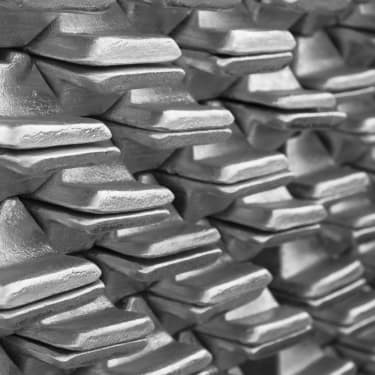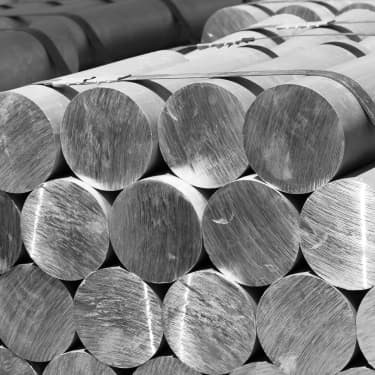Aluminium 101
What is Aluminium?
Aluminium (Al) is a silver coloured,
light metal with atomic number 13 and
density of 2.70 gr/cm3.
Aluminium, which is the most abundant element on earth after oxygen and silicon, is not found in pure form in nature; It exists in the form of oxidized and silicate compounds. Aluminium metal production is divided into two as primary and secondary production. Primary aluminium production is obtained from bauxite ores. Secondary aluminium is produced by recycling scrap aluminium.
Aluminium Production
90% of the world bauxite reserve is used in the production of aluminium, the rest is used in the chemical, refractory, abrasive and cement industries. Bauxite ore used in aluminium production generally contains 30-60% aluminium and is considered to be of exploitable value. Since bauxite deposits are generally formed near the surface, they are operated by open pit mining.
There are various methods for obtaining pure aluminium from bauxite ore. Among these methods, the Bayer method discovered by Carl Bayer is still the most widely used method in the world. In the first stage of pure aluminium production from ore; Alumina (Al2O3) is obtained from bauxite ore by Bayer method, and pure aluminium is obtained from alumina by electrolysis method in the second stage. About 4 tons of bauxite; 2 tons of alumina, 1 ton of metal aluminium can be obtained.
Industrial aluminium production was first realized in 1886 with the use of the electrolysis method. Aluminium, which was first used in electrical cables and home decoration products, was in high demand in the aircraft industry during the war environment of the 1939-1945 period. While aluminium sheets and plates found use in the construction industry in the 1960s, the packaging industry created a great demand for aluminium in the 1970s and 1980s, especially in the USA. After the oil crisis, with the widespread production of lighter cars, copper, steel and cast iron in the automotive sector began to be replaced by aluminium.
Why Aluminium?
Aluminium is preferred in many sectors due to its properties. One of its most important features is that it is a light metal. The density of aluminium is approximately one-third of the density of steel. Being a light metal, it provides energy saving in the areas where it is used. Therefore, it reduces the emission of greenhouse gases and other environmental pollutants. The strength of aluminium is increased by the addition of other elements. Aluminium, which is a flexible metal, provides design flexibility in applications and is preferred in the transportation and construction sectors due to this feature.
Having a natural oxide film layer, aluminium has a high degree of corrosion resistance. This feature can be further improved with different surface treatments. This feature extends the useful life of aluminium and also reduces the need for maintenance. Good heat and electrical conductivity make it preferred in electrical distribution and heat transfer systems and similar applications. It is completely sealed, even on very thin aluminium foils (7 μm thick). In addition, it is widely used in food and beverage packaging because aluminium itself is non-toxic and does not allow the aromas and flavours of the ingredients to be released. In addition to all these features, aluminium is a metal that is easy to recycle.
Less energy is required for recycling
and metal loss in the remelting process
is less than 3%.

Aluminium is preferred in
the electrical and electronics
industry because it is a
highly conductive metal.

Light, durable and functional
are the main features that
make aluminium one of the most
important engineering materials today.

Light, durable and functional are the main features that make aluminium one of the most important engineering materials today. Aluminium is a material worth using even with these features alone. Al, which has a very wide usage, is used in the houses we live in, in all transportation vehicles we use, in all kinds of cables, all kinds of cabinets, shelves, counters and kitchen utensils, in modern interior designs, as well as in many sectors such as food, medicine and chemistry.
Aluminium is used in building roof and facade cladding, in the construction of doors, windows and stairs. In addition to its durability, its decorative appearance offers rich options in the construction sector.
Aluminium is one of the most useful packaging materials. Its homogeneous structure, ability to be produced in the form of thin foil, airtightness and easy shaping make it an ideal packaging material. One of the most widely used areas is beverage cans. 80% of all beverage cans used in the world are made of aluminium.
Aluminium is one of the most important materials used in the production of vehicles in the transportation sector. Approximately 25% of aluminium use belongs to the production of vehicles. The lighter the vehicles are, the less energy they need to move, so the vehicles using aluminium consume less fuel. Especially in large vehicles such as buses, trains and trucks, the use of aluminium provides significant fuel savings. Lightness as well as strength of aluminium alloys increase their use in aircraft, ship and boat construction.
Aluminium is preferred in the electrical and electronics industry because it is a highly conductive metal. In high voltage electrical transmission lines, underground cables, electrical pipes, motor coil winding; It is also widely used in electronic device cases, chassis, transistor coolers and data recording disks.